Tata Steel Bundle
Who Really Owns Tata Steel?
Ever wondered who pulls the strings at one of the world's largest steel producers? The ownership structure of a company like Tata Steel, a titan in the Tata Steel SWOT Analysis, is far more complex than it seems. Understanding the "who" behind the "what" is crucial for anyone looking to navigate the steel industry and the broader market landscape.
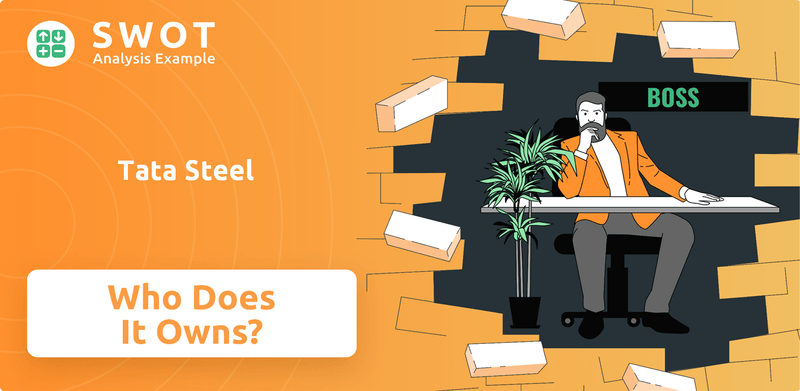
From its humble beginnings as Tata Iron and Steel Company (TISCO) in 1907, the Tata Steel story is one of evolution and strategic shifts. This article will unravel the intricate web of Tata Steel ownership, exploring its transformation from its founder's vision to its current status as a global powerhouse within the Indian conglomerate, the Tata Group. We'll explore the major shareholders, the Tata Group's influence, and the impact of these dynamics on Tata Steel's financial performance and strategic direction.
Who Founded Tata Steel?
The inception of Tata Steel, originally known as The Tata Iron and Steel Company Limited (TISCO), dates back to 1907. It was the vision of Jamsetji Nusserwanji Tata, though his sons, Sir Dorabji Tata and Ratan Tata, along with the broader Tata Group, brought his plans to fruition.
From its outset, Tata Steel's funding model was unique, primarily relying on Indian capital. This approach was a pioneering effort, demonstrating a strong commitment to self-reliance and national development. The Tata family, through the Tata Group and its various trusts, played a significant role in the company's ownership from the beginning.
The initial ownership structure of Tata Steel reflects a commitment to national development. The Tata trusts, which hold a majority stake in Tata Sons (the main holding company of the Tata Group), channel a significant portion of the dividends towards philanthropic activities, embedding a social responsibility ethos within the core ownership.
The initial funding for Tata Steel was primarily raised through Indian capital, a pioneering effort at the time.
The first shares offered to the public in India were oversubscribed within three weeks, highlighting the public's trust in the Tata name.
The Tata trusts channeled a significant portion of the dividends towards philanthropic activities.
The Tata family, through the Tata Group and its various trusts, held a significant controlling stake from the outset.
Early backers largely consisted of the Indian public and a few key financiers who believed in Jamsetji’s industrial vision for India.
The ownership structure reflected a commitment to national development, with the Tata trusts playing a crucial role.
Understanding the early ownership is crucial to grasping the foundation of the company. The Tata Group, through its various trusts, has maintained a significant controlling stake in Tata Steel since its inception. The initial public offering was a landmark event, demonstrating the trust and confidence the Indian public placed in the Tata name. For more insights into the growth and strategic decisions, consider reading about the Growth Strategy of Tata Steel.
- The Tata family and associated trusts were the primary owners.
- The public offering was oversubscribed, showing strong investor confidence.
- Early ownership emphasized national development and philanthropic activities.
- The Tata Group's influence has been consistent throughout the company's history.
Tata Steel SWOT Analysis
- Complete SWOT Breakdown
- Fully Customizable
- Editable in Excel & Word
- Professional Formatting
- Investor-Ready Format
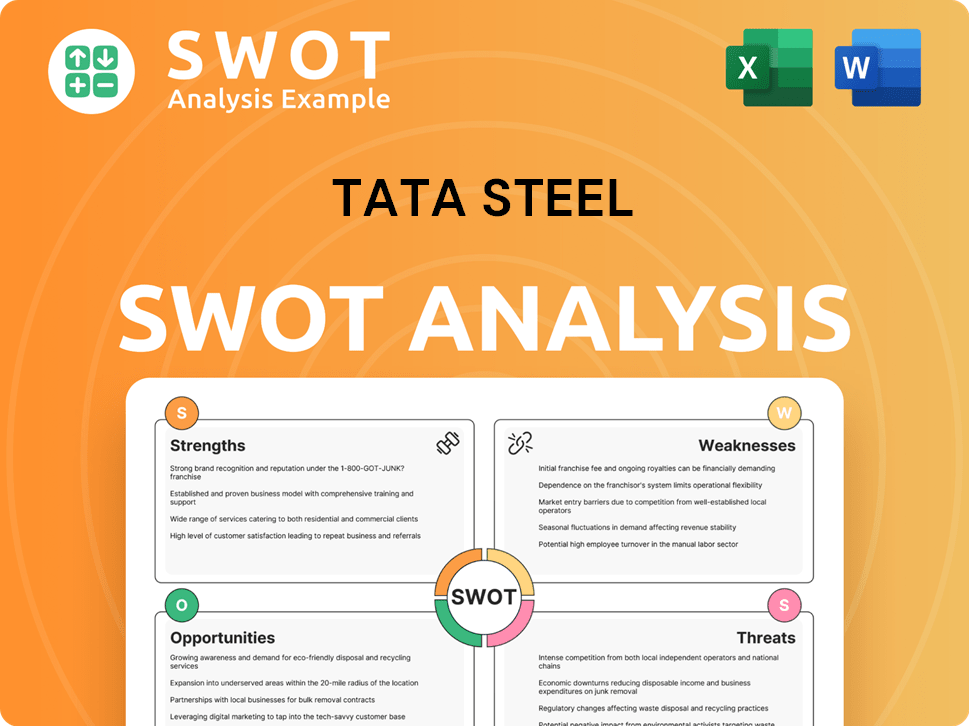
How Has Tata Steel’s Ownership Changed Over Time?
The ownership structure of Tata Steel has seen considerable changes since its initial public offering in 1907. As of early June 2024, the company, listed on the Bombay Stock Exchange (BSE) and the National Stock Exchange (NSE) in India, had a market capitalization of approximately ₹210,000 crore, which is about $25 billion USD. This evolution reflects the growth of the steel industry and the expansion of the Indian conglomerate.
The primary influence on Tata Steel's strategic direction and governance comes from Tata Sons Private Limited, the main investment holding company of the Tata Group. As of March 31, 2024, Tata Sons held roughly 33.7% of the equity share capital. The remaining shares are distributed among various institutional investors, mutual funds, foreign portfolio investors, and individual shareholders, representing a diverse ownership profile typical of a mature public company.
| Shareholder Category | Approximate Percentage (as of March 31, 2024) | Notes |
|---|---|---|
| Tata Sons Private Limited | 33.7% | Principal investment holding company of the Tata Group. |
| Mutual Funds | 9-10% | Holdings as of the end of fiscal year 2024. |
| Foreign Portfolio Investors (FPIs) | 20-22% | Collective holdings of foreign investors. |
Key events have shaped the ownership of Tata Steel, including capital raises, strategic acquisitions such as the 2007 acquisition of Corus Group Plc, and share buybacks. These actions have aimed to optimize capital structure and support growth while maintaining the Tata Group's overarching influence. The continuous adjustments in ownership reflect the company's adaptation to market dynamics and strategic objectives.
Tata Sons is the major shareholder, ensuring strategic control over Tata Steel. The remaining shares are held by a variety of institutional and individual investors.
- The ownership structure is typical of a large, publicly traded company.
- Major institutional investors include mutual funds and foreign portfolio investors.
- Strategic acquisitions and market activities continuously reshape the ownership landscape.
- Tata Steel's market capitalization was approximately $25 billion USD as of early June 2024.
Tata Steel PESTLE Analysis
- Covers All 6 PESTLE Categories
- No Research Needed – Save Hours of Work
- Built by Experts, Trusted by Consultants
- Instant Download, Ready to Use
- 100% Editable, Fully Customizable
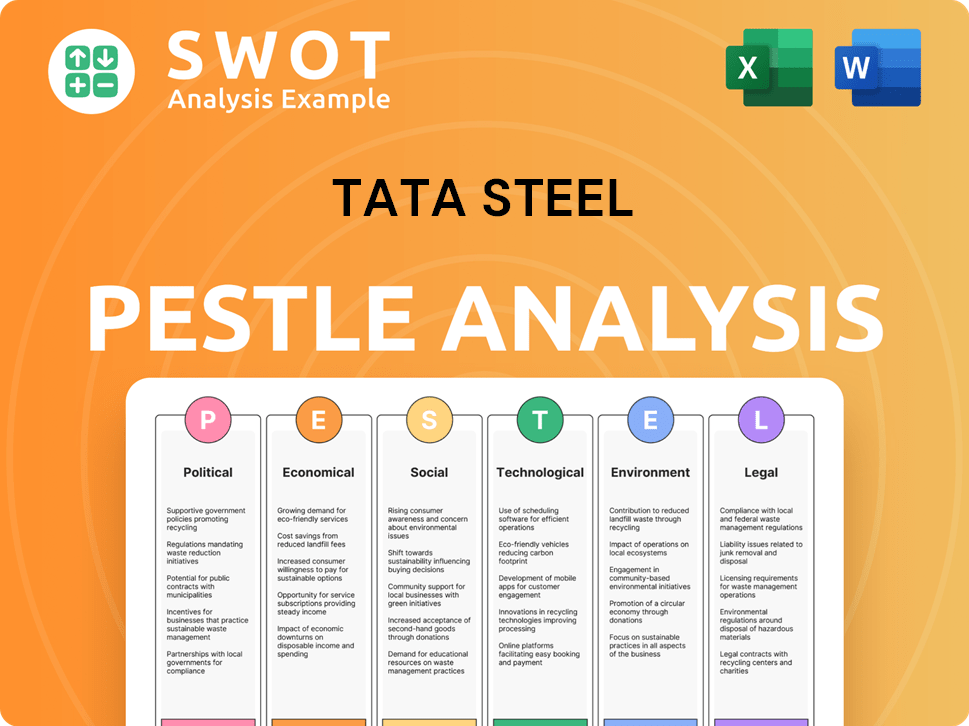
Who Sits on Tata Steel’s Board?
The Board of Directors of Tata Steel is pivotal in the company's governance, balancing the interests of its varied ownership. As of mid-2024, the board includes executive, non-executive, and independent directors. While specific individuals representing major shareholders aren't always explicitly labeled as 'shareholder representatives,' the composition often reflects the influence of the largest stakeholder, Tata Sons. The Chairman of Tata Sons frequently holds a position on the Tata Steel board, ensuring alignment with the broader Tata Group vision. This structure helps maintain strategic direction and oversight, crucial for a company of its size and global presence.
The board's composition and its oversight are key factors in understanding the dynamics of Tata Steel ownership. The presence of independent directors is particularly important for ensuring good governance and protecting the interests of minority shareholders. This setup provides a check and balance on the influence of the major shareholder, fostering a transparent and accountable environment. The board's decisions significantly impact the company's performance and strategic direction within the steel industry.
| Board Member Type | Description | Role |
|---|---|---|
| Executive Directors | Individuals with operational responsibilities within Tata Steel. | Oversee day-to-day operations and implement strategic initiatives. |
| Non-Executive Directors | Individuals without direct operational roles, providing independent oversight. | Offer strategic guidance and ensure accountability. |
| Independent Directors | Non-executive directors with no material relationship with the company or its management. | Ensure good governance and protect the interests of minority shareholders. |
The voting structure of Tata Steel generally follows a one-share, one-vote principle for its equity shares. This is standard for most publicly traded companies in India. There are no known dual-class shares or special voting rights that grant disproportionate control to any single entity or individual beyond their direct shareholding. However, the significant stake held by Tata Sons provides it with substantial voting power and control over major corporate decisions, including the appointment of directors and approval of strategic initiatives. While there haven't been major proxy battles or activist investor campaigns publicly challenging the core ownership structure in recent years, the board remains accountable to all shareholders. This balance of power is a critical aspect of understanding who owns Tata Steel and how decisions are made within the company.
The Board of Directors at Tata Steel includes a mix of executive, non-executive, and independent directors, ensuring a balance of operational expertise and independent oversight.
- Tata Sons, as the major shareholder, holds significant voting power, influencing key decisions.
- Independent directors play a crucial role in ensuring good governance and protecting minority shareholder interests.
- The voting structure is based on a one-share, one-vote principle.
- The board's composition reflects the influence of the largest stakeholder, Tata Sons.
Tata Steel Business Model Canvas
- Complete 9-Block Business Model Canvas
- Effortlessly Communicate Your Business Strategy
- Investor-Ready BMC Format
- 100% Editable and Customizable
- Clear and Structured Layout
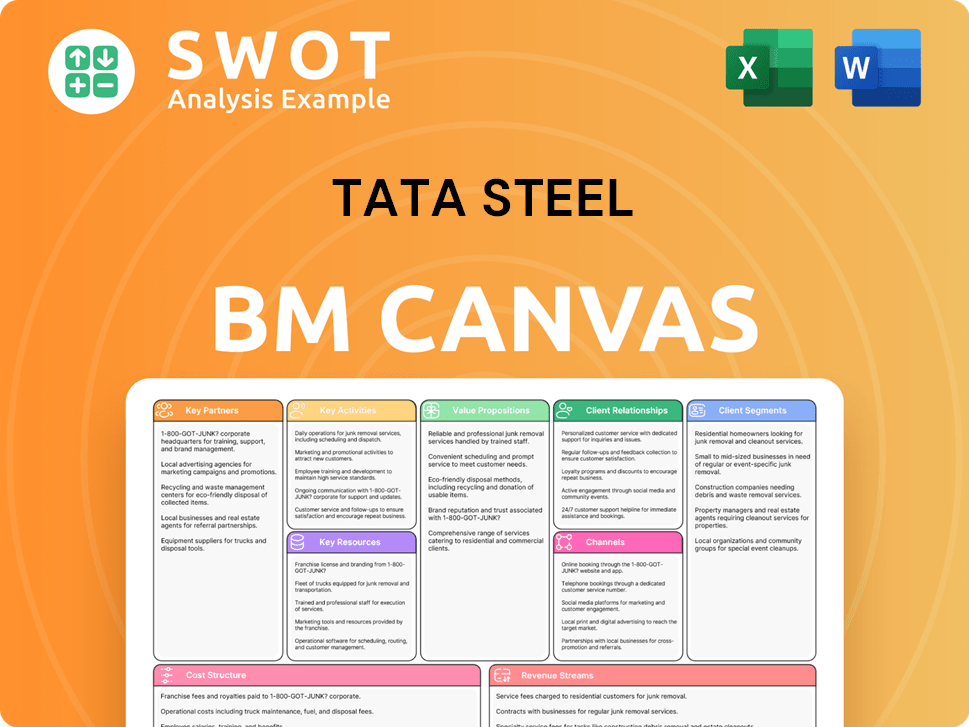
What Recent Changes Have Shaped Tata Steel’s Ownership Landscape?
Over the past few years, the ownership landscape of Tata Steel has seen shifts influenced by both company-specific strategies and broader industry trends. The company has focused on deleveraging its balance sheet and optimizing its portfolio. This has involved asset divestments and strategic restructuring, particularly of its European operations. These actions, while not directly altering the core ownership percentages of major shareholders, impact the company's valuation and investor appeal, indirectly affecting shareholder composition.
For example, ongoing discussions and strategic reviews regarding its UK operations, including potential government support or restructuring, have been closely watched by investors. In terms of ownership trends, there's been a general increase in institutional ownership in the Indian market, and Tata Steel is no exception. Large institutional investors and foreign portfolio investors continue to adjust their holdings based on market performance, economic outlook, and the company's financial health. The company has seen changes in its senior management and board composition, aligning with evolving strategic priorities.
| Shareholder Type | Approximate Percentage | Notes |
|---|---|---|
| Tata Sons | Around 34% | As of recent reports, remains the anchor investor. |
| Institutional Investors | Fluctuating, but generally increasing | Includes mutual funds, insurance companies, and foreign portfolio investors. |
| Retail Investors | Fluctuating | Affected by market dynamics and company performance. |
Looking ahead, public statements from the company and analysts often highlight the continued focus on sustainable growth, green steel initiatives, and operational efficiency, all designed to enhance shareholder value and attract long-term investors. The ownership structure is expected to remain stable with Tata Sons as the anchor investor, while the mix of institutional and retail investors will continue to fluctuate based on market dynamics and Tata Steel's performance. For a deeper understanding of the competitive environment, consider exploring the Competitors Landscape of Tata Steel.
Focus on deleveraging and portfolio optimization. Strategic restructuring of European operations. Increased institutional investor interest.
Tata Sons remains the anchor investor. Growing institutional ownership. Retail investor holdings fluctuate with market conditions.
Continued focus on sustainable growth. Emphasis on green steel initiatives. Operational efficiency to drive shareholder value.
Attracting long-term investors. Stable ownership structure. Fluctuations in investor mix based on performance and market dynamics.
Tata Steel Porter's Five Forces Analysis
- Covers All 5 Competitive Forces in Detail
- Structured for Consultants, Students, and Founders
- 100% Editable in Microsoft Word & Excel
- Instant Digital Download – Use Immediately
- Compatible with Mac & PC – Fully Unlocked
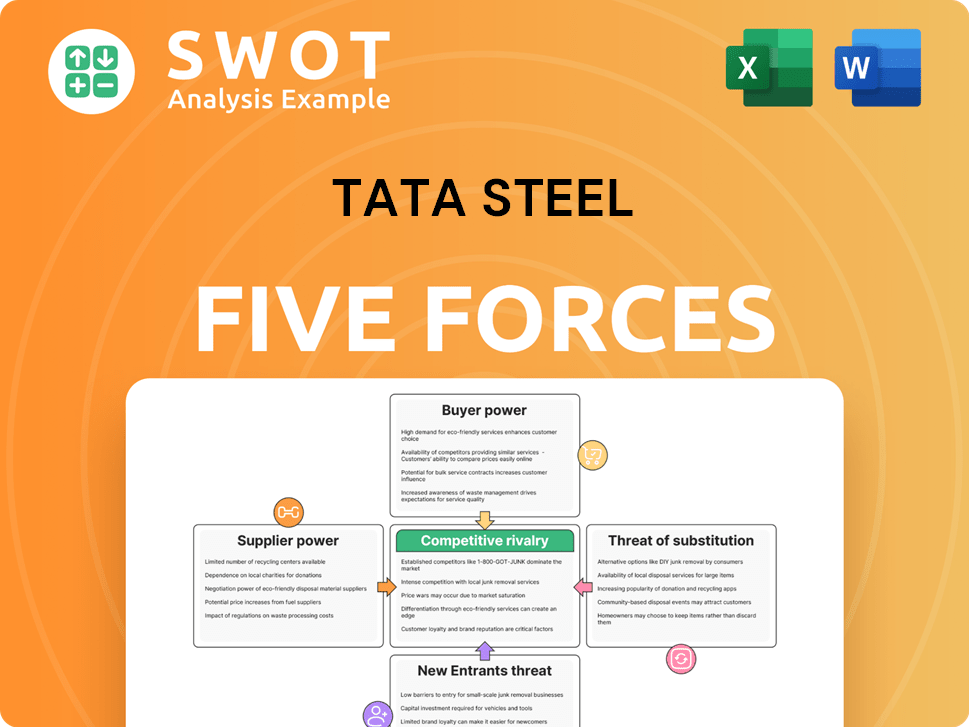
Related Blogs
- What are Mission Vision & Core Values of Tata Steel Company?
- What is Competitive Landscape of Tata Steel Company?
- What is Growth Strategy and Future Prospects of Tata Steel Company?
- How Does Tata Steel Company Work?
- What is Sales and Marketing Strategy of Tata Steel Company?
- What is Brief History of Tata Steel Company?
- What is Customer Demographics and Target Market of Tata Steel Company?
Disclaimer
All information, articles, and product details provided on this website are for general informational and educational purposes only. We do not claim any ownership over, nor do we intend to infringe upon, any trademarks, copyrights, logos, brand names, or other intellectual property mentioned or depicted on this site. Such intellectual property remains the property of its respective owners, and any references here are made solely for identification or informational purposes, without implying any affiliation, endorsement, or partnership.
We make no representations or warranties, express or implied, regarding the accuracy, completeness, or suitability of any content or products presented. Nothing on this website should be construed as legal, tax, investment, financial, medical, or other professional advice. In addition, no part of this site—including articles or product references—constitutes a solicitation, recommendation, endorsement, advertisement, or offer to buy or sell any securities, franchises, or other financial instruments, particularly in jurisdictions where such activity would be unlawful.
All content is of a general nature and may not address the specific circumstances of any individual or entity. It is not a substitute for professional advice or services. Any actions you take based on the information provided here are strictly at your own risk. You accept full responsibility for any decisions or outcomes arising from your use of this website and agree to release us from any liability in connection with your use of, or reliance upon, the content or products found herein.